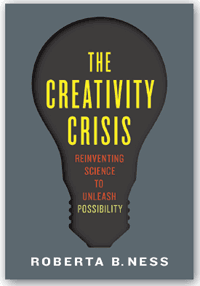
The Creativity Crisis: Reinventing Science to Unleash Possibility
Roberta B. Ness
287 pages, Oxford University Press, 2014
The Creativity Crisis takes its title from a 2010 Newsweek article that noted a decline in creativity among American schoolchildren. Roberta B. Ness extends that concept to argue that American society as a whole is unable to address grand challenges because academic science has become too cautious. The scientific community, for example, has done little to crack the problems of water scarcity, cancer, and obesity. Scientists, Ness contends, could also do more to change the food landscape by helping to improve manufacturing and supply-chain practices. “What if today’s system of science,” she asks, could enable a new generation of innovators “to overcome failures, to avoid the pressures of short-term profits, and to strive for something really audacious?”
Ness, a former dean of the University of Texas School of Public Health and vice president for innovation at the University of Texas Health Science Center at Houston, has previously written two other books on scientific creativity. The first one, Innovation Generation (2012), is a how-to guide for “thinking outside the box.” The second, Genius Unmasked (2013), recounts historical episodes of scientific discovery. Like those works, The Creativity Crisis is aimed at a general audience. Most of the literature that Ness cites to make her argument is popular rather than scholarly. There is a growing body of knowledge about how to use scientific resources effectively, and references to that research are largely missing from the book.
Ness frames The Creativity Crisis as an inquiry into the organizational, economic, and social factors that inhibit creativity at universities. She organizes the book around three sources of caution that, she argues, limit scientific innovation: the influence of money, social pressure, and an aversion to risk. Each of the book’s three sections includes a chapter that describes one source of caution, two chapters that present further analysis of that impediment, and a fourth chapter that provides recommendations for overcoming it.
In the book, Ness promises to off er new thinking on the topic of scientific innovation, but I did not find much creativity either in her analysis or in her proposed solutions. Is there really a “creativity crisis” in universities? From where I sit, as a professor who teaches entrepreneurship and innovation, the answer is no. Today, in university labs throughout the United States, there are new ideas in abundance. The word “crisis” strikes too dire a note. And the notion of “reinventing science” (to use a phrase from Ness’s subtitle) suggests a kind of hubris that seems inappropriate.
Solving grand social challenges requires input from all segments of society. More specifically, it requires orchestrated action by leaders in government, industry, and civil society to support scientific work. Consider the scourge of HIV/AIDS. In the 1980s, to be diagnosed with that virus was a death sentence. Today, thanks to a series of remarkable scientific advances, HIV/AIDS is a manageable condition. Anthony Fauci, director of the National Institute of Allergy and Infectious Diseases, observed in 2003 that those advances “represent a model of what can be accomplished when the world’s scientific community is galvanized in a common goal.” But a clear social mandate of that kind is rare. Despite significant research findings on the causes of obesity, for example, there is little social resolve to confront that problem on a large scale.
Ness focuses on the supply side of the scientific enterprise and does not consider the entire system in which scientists must operate. Attributing all of the problems associated with lagging innovation to academic science, she fails to hold stake holders in industry or government to account. Although her stated intent is to promote creativity, Ness does little more than document the well-known limitations of academia. Given that the process of innovation has become more complex and more dependent on multiple actors, dwelling on those limitations may be counterproductive.
Many of the examples in The Creativity Crisis come from the world of commercial innovation. Ness, for instance, suggests that academic scientists should be more like the automaker Henry Ford. She emphasizes his dedication to long-term technological change and his willingness to tolerate shortterm losses. But Ness ignores the fact that Ford was the leader of a for-profi t enterprise, not an academic. Certainly, to any academic who is trying to run a lab—and constantly writing grants to do so—the Ford approach will sound great. But scientists respond to incentives, just like anyone else, and the current system incentivizes a preference for caution rather than bold risk-taking. To revise that incentive structure, we as a society need to provide more favorable conditions for the pursuit of careers in science.

